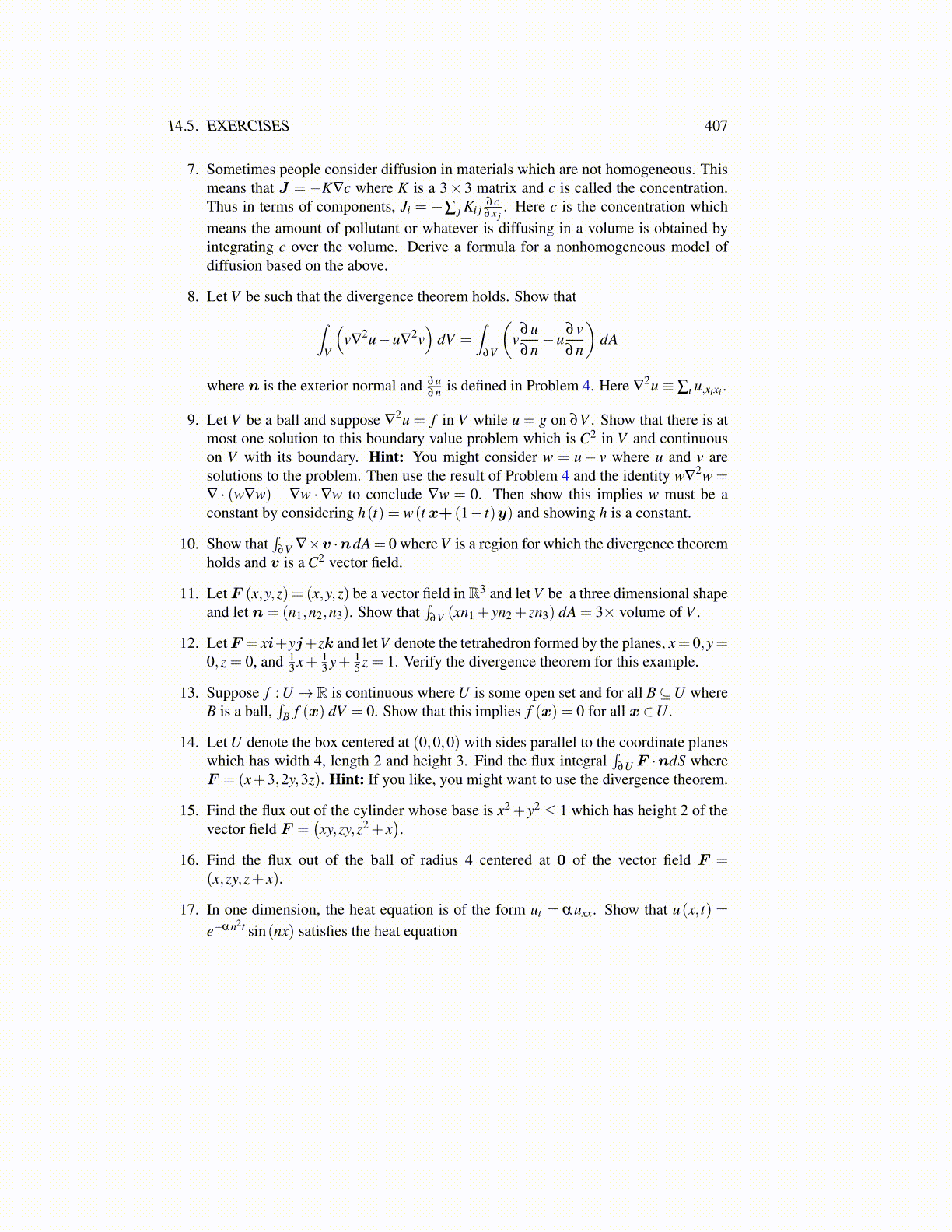
14.5. EXERCISES 407
7. Sometimes people consider diffusion in materials which are not homogeneous. Thismeans that J = −K∇c where K is a 3× 3 matrix and c is called the concentration.Thus in terms of components, Ji = −∑ j Ki j
∂c∂x j
. Here c is the concentration whichmeans the amount of pollutant or whatever is diffusing in a volume is obtained byintegrating c over the volume. Derive a formula for a nonhomogeneous model ofdiffusion based on the above.
8. Let V be such that the divergence theorem holds. Show that∫V
(v∇
2u−u∇2v)
dV =∫
∂V
(v
∂u∂n−u
∂v∂n
)dA
where n is the exterior normal and ∂u∂n is defined in Problem 4. Here ∇
2u≡ ∑i u,xixi .
9. Let V be a ball and suppose ∇2u = f in V while u = g on ∂V . Show that there is at
most one solution to this boundary value problem which is C2 in V and continuouson V with its boundary. Hint: You might consider w = u− v where u and v aresolutions to the problem. Then use the result of Problem 4 and the identity w∇
2w =∇ · (w∇w)−∇w ·∇w to conclude ∇w = 0. Then show this implies w must be aconstant by considering h(t) = w(t x+ (1− t)y) and showing h is a constant.
10. Show that∫
∂V ∇×v ·ndA = 0 where V is a region for which the divergence theoremholds and v is a C2 vector field.
11. Let F (x,y,z) = (x,y,z) be a vector field inR3 and let V be a three dimensional shapeand let n= (n1,n2,n3). Show that
∫∂V (xn1 + yn2 + zn3) dA = 3× volume of V .
12. LetF = xi+yj+zk and let V denote the tetrahedron formed by the planes, x= 0,y=0,z = 0, and 1
3 x+ 13 y+ 1
5 z = 1. Verify the divergence theorem for this example.
13. Suppose f : U →R is continuous where U is some open set and for all B⊆U whereB is a ball,
∫B f (x) dV = 0. Show that this implies f (x) = 0 for all x ∈U .
14. Let U denote the box centered at (0,0,0) with sides parallel to the coordinate planeswhich has width 4, length 2 and height 3. Find the flux integral
∫∂U F ·ndS where
F = (x+3,2y,3z). Hint: If you like, you might want to use the divergence theorem.
15. Find the flux out of the cylinder whose base is x2 + y2 ≤ 1 which has height 2 of thevector field F =
(xy,zy,z2 + x
).
16. Find the flux out of the ball of radius 4 centered at 0 of the vector field F =(x,zy,z+ x).
17. In one dimension, the heat equation is of the form ut = αuxx. Show that u(x, t) =e−αn2t sin(nx) satisfies the heat equation